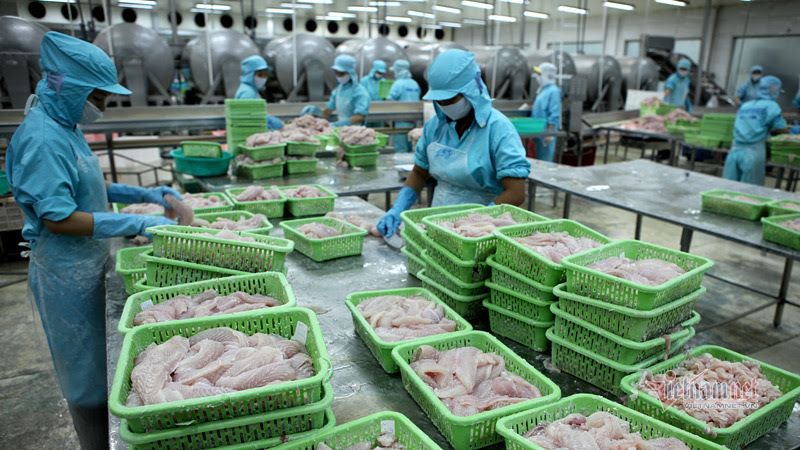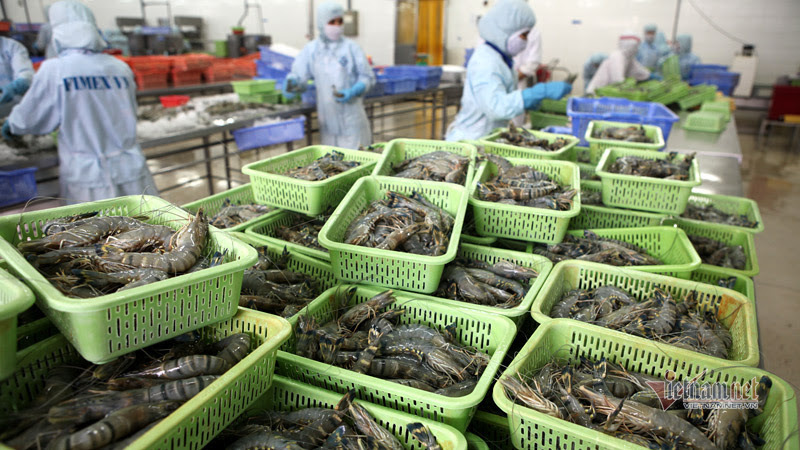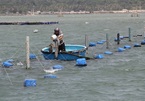Statistics show that Vietnam's seafood exports are flourishing. In March 2021 alone, Vietnam’s seafood export turnover increased by 17%. In the first quarter of 2021, Vietnam earned $1.7 billion from seafood exports, up nearly 7% year on year. Seafood export revenues in the first four months of the year were estimated at $2.39 billion, up 6.1%.
According to the Vietnam Association of Seafood Exporters and Producers (VASEP), shrimp exports have witnessed many positive signals in major markets in the EU and the US. The reason is that widespread vaccination in these countries has helped people feel more secure to resume their daily activities, which will aid the recovery of the economy, tourism and entertainment.
Vietnam’s export of shrimp, pangasius, tuna and other seafood products to the US is expected to increase strongly, especially shrimp exports, because the largest source of supply of shrimp to the US market – India - is facing difficulties due to the Covid-19 epidemic.
 |
|
Exports of tra fish (pangasius) to Russia increased by 700% in March 2020. (photo: Minh Dung)
|
The year 2021 is forecast to be a tough one for the Indian shrimp industry, as there is a shortage of containers, shipping costs have increases by 3 times, and fuel prices, packaging and labor costs have also risen. The Indian Rupee had strengthenef against the US dollar, and the government has removed export incentives.
In addition, a new wave of Covid-19 in the country has resulted in supply and price turbulence. Moreover, Indian shrimp is being attacked by the US shrimp industry, with a move to pressure the US government to tax 2% on Indian warm water shrimp, and at the same time it has accusef Indian shrimp producers of using forced labor and banned antibiotics.
Similarly, the Thai seafood processing industry is facing difficulties as the Covid-19 epidemic has become more complicated in this country.
This is seen as an opportunity for Vietnamese shrimp in particular and Vietnamese seafood in general to increase their market share around the world.
The US has also increased imports of pangasius from Vietnam. The US is currently the biggest customer of Vietnamese seafood. In the first three months of this year, seafood exports to the US reached nearly $334 million, up 16.5% year on year.
According to VASEP, other markets such as Australia, Canada, the UK, and Russia are prospective markets in the second half of this year because demand is increasing and there are no market barriers.
For the Russian market, pangasius exports in the first 3 months of this year increased 126% year on year and 700% in March 2020.
 |
VASEP forecasts that seafood exports in the second quarter of 2021 will increase by 10%, reaching about $2.1 billion. Shrimp export is expected to grow 10%, earning $980 million. Seafood export revenue this year may reach $8.8 billion, an increase of nearly 5% compared to 2020.
Mr. Nguyen Hoai Nam, Deputy Secretary General of VASEP, noted that businesses need to grasp market trends to change production accordingly. Consumption habits in foreign markets have changed. Under the impact of the pandemic, demand for fresh and raw seafood products continues to decline and the need for canned and dry products is on the rise.
Nam also said that seafood businesses need to build a traceability system in the entire production process from raw materials to product processing.
VASEP Secretary General Truong Dinh Hoe said that the new generation free trade agreements such as CPTPP, EVFTA, RCEP will be a "lever" for seafood exports. However, in order for Vietnamese products to conquer a variety of markets, it is necessary to have both quality and appearance.
Tam An

Vietnam’s $8 billion seafood industry warned of risks
Vietnam’s seafood exports have bounced back after a period of sliding, but there has been a spread of disease among some shrimp and fish breeding areas.